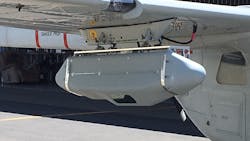Navy picks Logos Technologies to provide wide-area motion imagery (WAMI) sensor for RQ-21A unmanned aircraft
PATUXENT RIVER NAS, Md. – U.S. Navy aerial surveillance experts needed a wide-area motion imagery (WAMI) sensor for the Boeing Insitu RQ-21 Blackjack small tactical unmanned aerial vehicle (UAV). They found their solution from Logos Technologies LLC in Fairfax, Va.
Officials of Naval Air Systems Command at Patuxent River Naval Air Station, Md., have awarded Logos a $6.7 million contract to develop, deliver, and perform proof-of-concept flight tests on a WAMI sensor called Cardcounter for the Navy and Marine Corps RQ-21A Blackjack UAV.
Cardcounter will be derived from Logos BlackKite sensor -- an ultra-lightweight WAMI sensor prototype with infrared sensing capability.
BlackKite, on which Cardcounter is to be based, weighs less than 28 pounds, yet is powerful enough to image an area of more than about five square miles to detect and track all land vehicles in real time.
The Cardcounter WAMI sensor will capitalize on BlackKite's high-performance, multi-modal edge processor, which can store six or more hours of mission data.
With this technology, users can analyze the recorded imagery forensically to determine what is unfolding in the real-time imagery, drawing connections between people, places, and events.
The initial $6.7 million Navy contract covers development of two Cardcounter prototypes, with delivery and flight testing by September 2020 aboard the RQ-21A Blackjack.
Designed to provide battlefield reconnaissance capability for Navy and Marine Corps field commanders, the RQ-21 is a twin-boom, single-engine, monoplane UAV. Users can launch and recover the reconnaissance drone on land or at sea without runways by using a pneumatic launcher and net-type recovery system. Boeing Insitu in Bingen, Wash. is the Blackjack designer.
Related: Army asks industry for wide-area electro-optical sensors for manned and unmanned aircraft
The 81-pound Blackjack is eight feet long with a 16-foot wingspan, and is designed to carry multi-sensor payloads in a large pod below its nose. The UAV can fly as quickly as 104 miles per hour, cruises at 63 miles per hour, can fly as long as 24 hours, and can fly as high as 19,500 feet. It is a version of the Insitu Integrator UAV.
Users can customize the RQ-21A Blackjack's multi-mission open-architecture payload bays with visible-light and infrared cameras, communications, and other tools to provide situational awareness information to warfighters on the forward edge of battle.
The drone can integrate new payloads quickly, offers roll-on, roll-off capability to move the system quickly from ship to shore, as well as to and from cargo aircraft. The UAV can carry sensor payloads as heavy as 39 pounds.
The Blackjack's standard sensor payload consists of a visible-light imager, mid-wave infrared imager, laser rangefinder, infrared marker, communications, and automatic identification system.
Related: Maintaining a constant reconnaissance eye
The RQ-21A will provide persistent maritime and land-based tactical reconnaissance, surveillance, and target acquisition (RSTA) data collection and dissemination capabilities to sailors and Marines.
For the Marine Corps it will provide the expeditionary force, divisions, and regiments with a dedicated intelligence, surveillance, and reconnaissance (ISR) system that sends information to the tactical commander in real time.
For the Navy the Blackjack will provide persistent RSTA information to Navy ships, Marine Corps land forces, Navy expeditionary combat command forces, and Navy special warfare units.
For more information contact Logos Technologies online at www.logostech.net, Boeing Insitu at www.insitu.com, or Naval Air Systems Command at www.navair.navy.mil.
About the Author
John Keller
Editor-in-Chief
John Keller is the Editor-in-Chief, Military & Aerospace Electronics Magazine--provides extensive coverage and analysis of enabling electronics and optoelectronic technologies in military, space and commercial aviation applications. John has been a member of the Military & Aerospace Electronics staff since 1989 and chief editor since 1995.
